#aztec jewelry
Explore tagged Tumblr posts
Text
Vintage Mexico Aztec Calendar Sterling Silver Drop Dangle Earrings

These pretty and petite Aztec calendar sterling silver drop dangle earrings were skillfully crafted by world-renowned Mexican silver jewelry artisans.
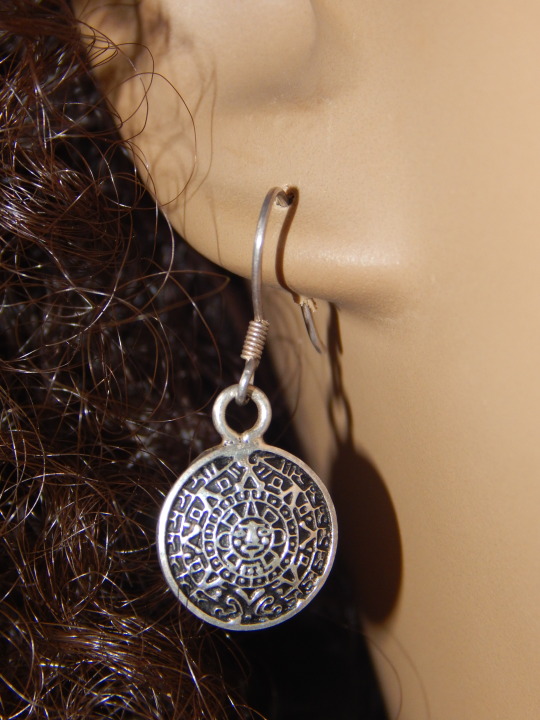
The calendar is etched onto a bed of black oxidized sterling silver, and they have a natural, undisturbed patina. These tiny earrings make a remarkable statement of heritage, art, and history and will be a definite conversation starter when worn!

#mexico#mexican#mexican jewelry#mexican silver#mexican earrings#aztec calendar#aztec jewelry#ciudad de mexico#veracruz#oaxaca#chiapas#zapotec#olmec#guatemala#belize#honduras#el salvador#central america#aztecs#aztec#maya#mayan#vintage earrings
0 notes
Text

~ Skull Necklace.
Culture: Aztec
Period: Late Postclassic
Date: A.D. 1200-1520
Medium: Shell
#13th century#16th century#aztec#history#museum#archeology#archaeology#jewelry#Mesoamerica#mexico#mexican#pre columbian#late Postclassic#shell#necklace#skull#skull necklace#a.d. 1200#a.d. 1520
3K notes
·
View notes
Text
What traditional patterns and symbols can be seen in Aztec jewelry?
The Ollin sign, an important part of Aztec mythology, was engraved on a lot of jewelry.
Quetzalcoatl Feathered Serpent: Often depicted in Aztec jewelry, the mythical deity Quetzalcoatl is a feathered serpent believed to represent creation and rebirth.

Glyphs and Hieroglyphs: Aztec jewelry frequently incorporated glyphs and hieroglyphs with several meanings. These symbols could be used to spell out words, dates, or important occasions.







Skulls and the Afterlife: The Aztecs had a distinctive view of the afterlife. Skulls were frequently carved into gemstones or made of rich materials like obsidian and used in jewelry to pay homage to departed ancestors or serve as a reminder of mortality.
Sun and Moon Motives: In Aztec mythology, the sun and moon were deities, and jewelry design frequently featured their symbolism.




The sun was portrayed by intricately patterned gold and silver discs, while the moon was represented by crescent-shaped objects.


Aztec jewelry also included animal motifs that were inspired by the natural world. In their culture, animals like frogs, jaguars, and eagles carried special significance.


Materials and Gemstones: The Aztecs had access to a wide range of materials and gems, which they expertly incorporated into their jewelry.
0 notes
Text
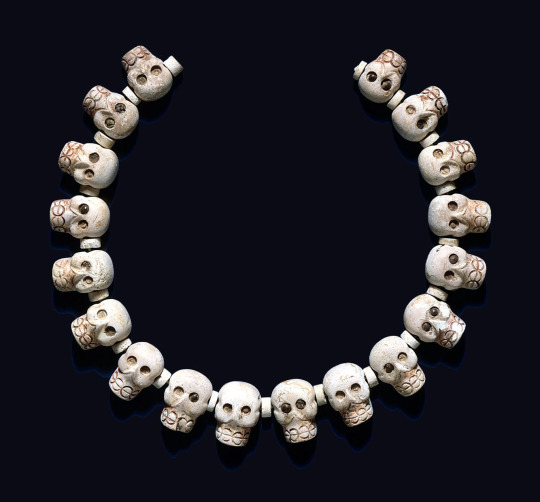
Skull Necklace Aztec, Late Postclassic, 1200-1520 CE
The impressive motif of this necklace is presented by 18 nearly identical carved shell beads in the shape of skulls, separated from one another by simple disk spacer beads. All were carved from thick shell that has been identified as Spondylus, possibly Spondylus princeps. The symbolism of this necklace plays with two concepts: the fertile waters of the home of the shell and the fertility ensured by human sacrifice. The carved beads suggest the dry, bleached crania of sacrificial victims as they were displayed in the temple complex on the public skull rack (tzompantli in Nahuatl). The cord passing through the skulls mimics the way in which skulls were arrayed on wooden poles on the rack. Life and death are thus interlinked and dependent on each other.
325 notes
·
View notes
Text

600 year empire.🥇🏆💰🗡⚔️🛡💎(mixed media on canvas)🥇
#aztec#aztec mythology#aztec gods#azteca#aztec culture#aztek#aztec empire#mayan mythology#Mayan#mayan civilization#gold jewelry#gold#gold rush#gold nugget#golden#andalusia#sevilla#madrid#conquest#conquistador#conquistadors#Peru#Mexico#tenochtitlan#warrior#ancient history#basquiat#pop art#contemporary art#fine art
3 notes
·
View notes
Text

Aztec Mayan Face Mask Necklace Carved Mexico Brass Copper Green Aventurine Stone ebay Fabrincollectibles
2 notes
·
View notes
Text

The Intersection of Art and Fashion: How Ancient Pre-Columbian Designs Influence Modern Trends
#ancient art#ancient history#archaeology#pre-columbian#art history#artifacts#inca#aztec#mayan#south america#mesoamerica#costa rica#necklace#ancient#tiger#jade#jewelry#Ancient jewelry
1 note
·
View note
Text

Aztec Paper Clip Chain (n/a) & Dew Drop Heart Locket ($575) from Anzie Jewelry
#natalya#natalya wwe#nattie neidhart#Aztec Paper Clip Chain#chain#chains#Dew Drop Heart Locket#locket#lockets#Anzie Jewelry#women of wrestling fashion#wwe#wwe raw
2 notes
·
View notes
Text
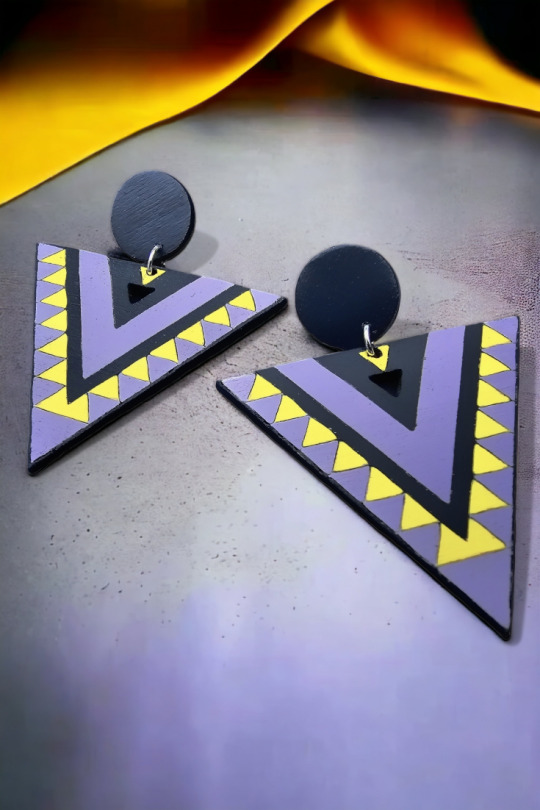
Handmade and handpainted wooden earrings - black-purple-yellow aztec style earrings with handmade studs
#crafts#handcrafted#handpainted#earrings#jewellery#jewelry#jewlery#handmade#boho life#bohochic#aztec#wooden jewelry#earings#etsy#statement earrings#handmade earrings#hand painted earrings#boho earrings#etsyearrings#etsyjewelry#etsyuk#etsyseller#jewerly#uniquejewelry#unique#ukrart
3 notes
·
View notes
Text


Vintage sterling silver sun stone design Aztec style cuff links
#vintage#vintage goods#vintage jewelry#sterling silver#aztec#sun calendar#sun stone#mexican silver#sterling#silver#silver jewelry#cufflinks#cuff links#mens jewelry#menswear#mens fashion
1 note
·
View note
Text


Huge Southwestern Sterling Silver Aztec Mayan Chief And Tonatiuh Sun Gold Medallion Pendant With Rope Chain Vintage - A protection piece PRICE: 150.00 LINK ↓
#fine jewelry#jewelry#estate jewelry#small business#jewelry for sale#michigan#howell michigan#vintage jewelry#shop small#shop local#sterling silver#silver pendant#silver jewelry#pendants#bigjewelry#southwestern#mayan chief#aztec#tonatiuh#sun god
0 notes
Text
Thrifty Thursday !
To my fellow Jewelry Addicts, never been to Blingschlingers.com, use discount code : WELCOME for an additional 10% off our already Low Prices! No Minimum Required!
Save Big + Your Shopping Green ♻ with our Sterling Silver & Gold Estate Jewelry !
oh BTW.. these bold & unique cuff-links are only $18.00! 🤩
#jewelry#sterling silver#silver#accessories#mens accessories#menswear#mens jewelry#mensfashion#cufflinks#links#cuff#black#fine jewelry#carved#mayan#style#aztec#design#thrifting#thursday
0 notes
Text
Peach Aztec Earrings

Peach Aztec Earrings
Handcrafted with MDF wood and stainless steel hooks
$8.00
0 notes
Text
Can you describe the craftsmanship methods used to create Aztec jewelry?

The magnificent jewelry worn by the Aztecs, a civilisation renowned for its rich cultural history and mastery in metalsmithing, expressed their beliefs, prestige, and relationship to the divine.

The craft of goldwork, in which Aztec artists expertly sculpted and moulded gold to create gorgeous things that stunned observers, was one of the most well-known techniques.

As a reflection of the Aztecs' intimate ties to nature and spirituality, the meticulously crafted patterns frequently included symbolic themes like serpents, feathers, and sacred animals.


The Aztecs used the process of gemstone inlay in addition to goldwork to increase the appeal of their jewelry.

Lost-wax casting was another impressive craftsmanship technique used by the Aztec jewelers.

This complex procedure entailed making a wax replica of the desired jewelry item, which was then put within a clay or plaster cast.

A cavity in the shape of the original model was left behind after the wax melted and escaped from the heated mold.
1 note
·
View note
Text

Pair of Ear Spools
Mixtec-Aztec, Postclassic, 900-1520 CE
Ear piercing was among the most common of body modifications in ancient Mesoamerica, attested to by depictions in art and the great variety of ear ornaments. Materials ranged from paper and reeds to gold and jade. Shapes and sizes varied also, but most incorporated a cylindrical shaft, which might serve as the armature for more elaborate ear adornments or might itself be the adornment, sometimes called an “ear spool” after its shape (an alternate term, “ear plug,” invites confusion with the modern meaning of this expression). Ear spool cylinders were generally hollow and flanged at both ends.
53 notes
·
View notes
Text

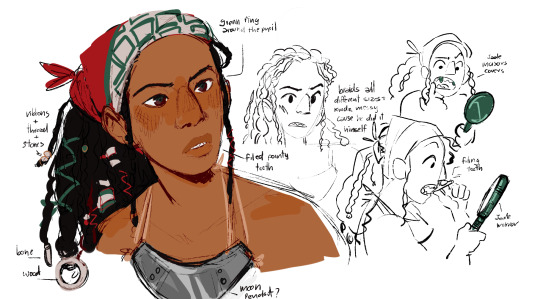
Redid my Maya Knux gijinka! Now with notes and sources on how I did the design (It's kinda long, around 2k words jsyk):
The hairstyle:
Knux has pretty long spikes, so I knew I wanted to give him long hair! Braids or dreadlocks look pretty fitting, so I tried looking for references of hairstyles to see if any fit what I was looking for:
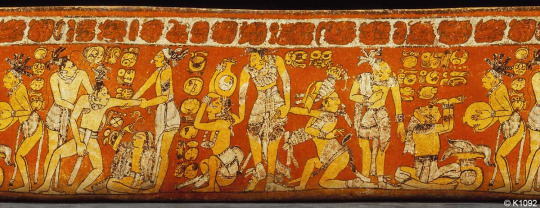
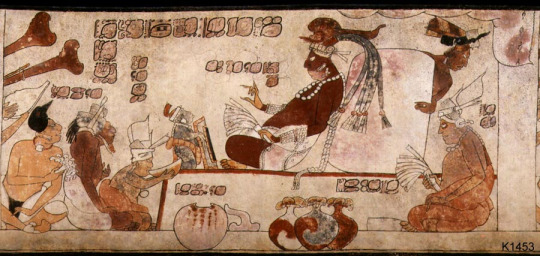

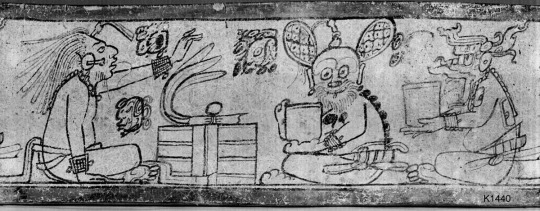
Source: Mayavase.com (Photograph by Justin Kerr)
http://research.mayavase.com/kerrmaya_hires.php?vase=1092
http://research.mayavase.com/kerrmaya_hires.php?vase=1453
http://research.mayavase.com/kerrmaya_hires.php?vase=694
http://research.mayavase.com/kerrmaya_hires.php?vase=1340
While all the vases show a variety of interesting hairstyles, I particularly loved the look of the braids in K694 (the third picture). Being tied upwards wouldn’t really fit Knux however, so something like the man in K1340 (fourth pic) with his hair fully down, or the 5th man from left to right in K1092 (first pic) with a cloth holding the hair would be really nice!
I didn’t want to give him a headpiece, if only to not clutter his head, but also I didn’t think it’d fit Knux as a warrior. The ruler’s headpiece in K1453 (second pic) however allows the hair to come off it, and seems to have some dangly adornments on the end of the strands/braids/locks, which I found super pretty. Plus:
“Elite Mayan men and women styled their hair to show off their pointed heads, crafted through the careful head flattening they experienced as children. Women gathered their long hair on top of their heads in flowing ponytails. For special occasions they braided their ponytails and decorated them with ornaments and ribbons. Mayan men grew their hair long but burnt the hair off their foreheads to accentuate their elongated profiles. They would bind their hair into one or many ponytails or tie it in a bundle on top of their head. Mayan slaves had their hair cut short as one visible mark of their inferior status.” p.399
Source: Fashion, costume, and culture: clothing, headwear, body decorations, and footwear through the ages (Sarah Pendergast and Tom Pendergast, Sarah Hermsen as Project Editor), 2003.
https://archive.org/details/fashioncostumecu0000pend/page/n5/mode/2up
Taking all of that! I settled on tight braids with a few adornments made of jade and wood, with a red cloth to keep his hair from his eyes. Almost all of the braids are pulled together into a ponytails, but there are some smaller braids loose.
It’s somewhat of a mixture of styles, combining ornaments of special occasions, with the long hair of elites on a character like Knux. But I kept these ‘contradictory’ aspects of the design to remember that Knux kinda learns about his ancestors on the go, through murals, writings and technology, so I doubt he’d have a great grasp on what he should and shouldn’t wear. I think it adds character as someone who’s trying to figure out himself, his history and his place in the world.
Shoes and Accessories:
For footwear I kept it simple, just turned Knux’s existing shoes into sandals:
“Ancient Aztecs and Mayans of Central America adopted a thick-soled sandal with a protective legging attached at the heel, while the top of the foot and shin remained exposed.” p.135
Source: Encyclopedia of Clothing and Fashion (Valerie Steele), 2005
Although my gut instinct was to cover Knuckles from head to toe in accessories, I also tried to keep it simple like the shoes. He’s a very mobile fellow so he can’t have too much weight or annoying bits flying everywhere and getting in his face. So I kept his moon necklace, like in Fleetway, just adjusted the shape to have a bit more of details:
“The jewelry worn by the Mayan, Aztec and Inca people was rich in variety and quite beautiful. Without metalworking skills, Mayans made jewelry from many materials. Mayan men wore nose ornaments, earplugs and lip plugs made from bone, wood, shells and stones, including jade, topaz, and obsidian. Necklaces, bracelets, anklets and headgear were made with jaguar and crocodile teeth, jaguar claws and feathers.” p.402
Source: Fashion, costume, and culture: clothing, headwear, body decorations, and footwear through the ages (Sarah Pendergast and Tom Pendergast, Sarah Hermsen as Project Editor), 2003.
https://archive.org/details/fashioncostumecu0000pend/page/n5/mode/2up
As stated here, Mayans didn’t have metalwork, so I imagine this is an artifact that his ancestors got from another group of people.
Just a page before they also mention how the Maya people used to file points into their teeth, to make their mouths more appealing. This includes shaping them into pointy teeth, (like the classic shark teeth), but they could also file them into other shapes, like in this picture:
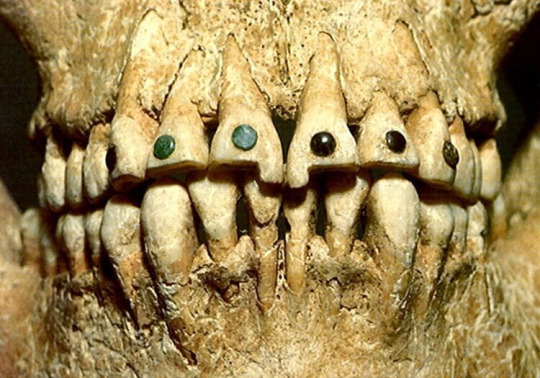
Source: https://www.archaeologynow.org/blog-3/blog-post-title-two-txwxl (I’m pretty sure this isn’t the source of the image, but I couldn’t find an actual source that wasn’t an uncredited blog)
The Maya people are also notorious for their good dentistry, as seen the stone ornaments in the teeth above. I think the filling is something Knux could do on his own, but anything that would involve actual dentistry would be too much. But it’s still interesting to read about!
(Here’s an article named “Mayan Esthetic Dentistry: Using Modern Techniques and Digital Imaging Technologies to Link the Past to the Present” by Yassine Harichane if you want to learn more!)
While a non-permanent version of stones on teeth seemed cool, like Jade incisor-coverings, at the end of the day I don’t think Knuckles is too vain, so I didn’t add that to the design. Although I think he’d definitely try out a bunch of things like this, just to try to understand them.
For additional outfits I gave him a red layered cape and a green huipil! The red cape is just to bring back more red into the design, since I gave him a lot of green. And the huipil is a nod to his poncho in the comics! (Although huipiles are commonly associated with women and girls, I still wanted to give him one, not only to bring up his partial detachment to his ancestors, but also because Knux probably wouldn’t think much about gender in general let’s be honest)

Source: Mayavase.com (Photograph by Justin Kerr)
http://research.mayavase.com/kerrmaya_hires.php?vase=638
Somewhat based the red cape on the 4th man in this picture, from left to right, but I kept it simple, as maybe just some fabric Knux found around the island, nothing too fancy.
For the huipil I wanted to do something more detailed but was having a really hard time coming up with designs. And I didn’t want to straight up plagiarize someone’s else work, so I kept it vague, maybe some day I’ll sit down and give it a more detailed version. I did come across a very nice store/ catalog that sells traditional Maya textiles, and this one was very gorgeous! Highly recommend give this and the other textiles a look!
In the end I made the huipil look vaguely like the ones shown in page 128 of the following book:
“In the Museum collection, costumes that looked very much alike usually turned out to be from villages that shared a language. Among Cakchiquel villages, dialect differences were usually mirrored by costume differences. Working on this principle we were surprised by the striking similarity of style in the huipils of San Antonio Aguas Calientes (fig. 195) and San Martín Jilotepeque (fig. 196). These villages, while both Cakchiquel, spoke very different dialects and were separated geographically (map, below). The similarity of their huipil was so remarkable we felt the need to investigate these two villages more thoroughly and found that a multi-cultural history probably accounted for these unexpected similarities of style. Huipils from these villages may well illustrate the earliest examples of pan-Maya acculturation after the Conquest.”p. 127
Source: Threads of identity: Maya costume of the 1960s in highland Guatemala (Patricia B. Altman, Caroline D.West), 1992.
https://archive.org/details/threadsofidentit0000altm/page/n7/mode/2up
Lastly on accessories, which I don’t know if it counts as an accessory but I didn’t know where to put it: the body paint. Last time I gave Knux a human design I couldn't find a good resource on Maya people painting their bodies. Every source mentioned and was in consensus that some of the people did paint their bodies, but that was the extent of the info. I wasn’t able to find any patterns or meanings of the body paintings, or even good visual reference for it. But! This time I was able to get a bit more:
“Body painting was a common Maya practice. Classic Period murals and polychrome vases depict warriors covered with red or black paint; sometimes their bodies were striped with red paint. Paint was also used around the eyes and nose to give a fierce expression. In the 16th century, these practices continued. Women also applied red paint to their faces and bodies, but presumably to make themselves look beautiful, not fierce. Small paint jars of red hematite mixed with mica were found in the houses at Cerén, and these may have been for cosmetic use. Unmarried young men painted their bodies black, and so did those who were undergoing periods of ritual purification and fasting. Priests often wore blue body paint. “p. 338
Source: Handbook To Life In The Ancient Maya World Lynn (V. Foster), 2002.
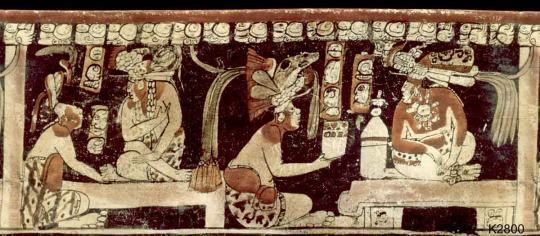
Source: Mayavase.com (Photograph by Justin Kerr)
http://research.mayavase.com/kerrmaya_hires.php?vase=2800
http://research.mayavase.com/kerrmaya_hires.php?vase=2573
http://research.mayavase.com/kerrmaya_hires.php?vase=7996
I of course wanted to give him red paint, and I really liked this design of the red lining the cheeks on the face down to the neckline. However in most of these depictions the red on the body is accompanied by the white face, which I can’t actually tell if the face has white paint, or the body has black paint, like described in the quote before. Either way I chose to only use the red, to keep in line with Knux’s original design.
(It’s worth mentioning that these vases shown depict rulers, as you can see the intricate thrones and altars, which isn’t really fitting with Knux. But again, I want to keep some mismatched aspects into his design, not only warrior-related things.)
The main outfit:
Last but not least, the main outfit. Don’t have much notes on this I’m going to be honest, I just tried to keep in line with descriptions of warriors clothing:
“While some warriors may have been resplendent on the battlefield, the common Maya soldier fought with little clothing other than loincloth and body paint, based on battle scenes in the few Maya murals that remain (see figure 2.9, page 54).” p.147
Source: Handbook To Life In The Ancient Maya World Lynn (V. Foster), 2002.
I considered putting him in a loincloth for accuracy, but tbh I was scared people were going to be weird about it, and so I gave him a skirt with some fabric that emulates the look of a loincloth and some scrap fabric around his waist and limbs! He actually ended pulling up a lot from the dude I mentioned in vase K1092 (the very first ref pic in this post) lol!
And that´s all, hope y’all liked it :P
1K notes
·
View notes